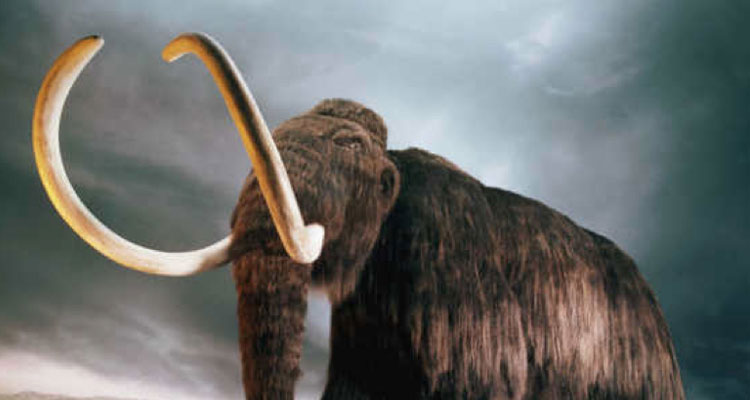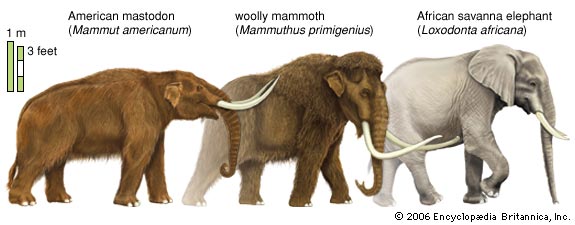I always enjoy visiting the New York State Museum and viewing the exhibit that features a diorama of a scene from upstate New York at the end of the last Ice Age. The vast fields of glaciers that laid bare the surface of the state help me meditate on how things were 13,000 years ago. The land was bereft of trees; just a vast expanse of rolling tundra.
If you or your kids were to imagine living during this time, you would have to envision living among mammoths and mastodons. And you would have known that the mastodon and the mammoth are two different kinds of animals. A mastodon (the genus Mammut) is huge but it is squarer and more block-like than the near-elephant that is the mammoth (the genus Mammuthus). Both have enormous tusks that make a great overhead beam. See these images for comparison:
Back in 2012, two researchers from the New York State Museum, Robert S Feranec and Andrew L. Kozlowski, dated ten fossil specimens. These animals were thriving in New York State about 12,000–15,000 years ago. And they were magnificent creatures.
Now they are gone.
Up until now, it has been commonly believed that that our ancestors killed every last living mastodon and mammoth. A conclusion that is enormously sad.
But maybe that is not the case.
The thing about science is that it doesn’t stop with “common knowledge.” (If it did, Myth Busters would be out of business.) The very first step in the entire process of science is to ask questions. And a Russian scientist named Sergey Leshchinskiy from the Laboratory of Mesozoic and Cenozoic Continental Ecosystems at Tomsk State University asked a good one: Could something besides human hunting have caused the extinction of the woolly mammoth? Leshchinskiy and others have long known that most of the woolly mammoths in Siberia died from disease. It has long been assumed that human hunting reduced populations so much that these animals were weakened and susceptible to disease. But, asked Leshchinskiy, what if something other than human hunting was weakening these animals?
Leshchinskiy studied the bones of mammoths from the end of the megafauna era in Siberia and was struck by the fact that many of these animals suffered from “osteoporosis, osteofibrosis, osteomalacia, osteolysis, cartilage atrophy, exostoses and fractures, resulting in the formation of false joints, ulcers and friction grooves on articular surfaces.”
In short, something was causing the skeletons of woolly mammoths basically to disintegrate. In a recent article, Leshchinskiy suggested that widespread change in the ground—the very dirt itself—may have led to this skeletal breakup. It turns out that woolly mammoths need to eat clay and mud because they need a lot of minerals. As the climate of Siberia and northern Russia changed, the beast solonetz (mineral licks) dried up. The mammoths could no longer get enough of the minerals they needed, and after perhaps ten thousand years or more, the health of individuals declined, populations grew smaller, and finally the mammoths were gone.
I urge you and your students to explore the science more, but there are some big lessons here on how science works. Scientists don’t take things for granted. They ask question. They test things, they gather evidence, they analyze data, and they form conclusions. Leshchinskiy did that. And all science students should as well.
But here is another science question: What if Leshchinskiy is wrong? Let’s put it this way: IF the lack of mineral licks DID NOT cause the end of the mammoth, THEN there should be evidence to support that. An IF-THEN statement like this is called a hypothesis. Further, if additional studies confirm Leshchinskiy’s idea, support it with more and more facts, then we might say we have a THEORY. To a scientist, a theory is a broad statement backed up by a significant body of facts.
Progress in science always starts with a question, a doubt, or someone saying, “Hold on there.” Einstein basically started by saying something similar to, “Hey maybe we got this time thing all wrong.” Wegener may have said, “Well, what if the continents aren’t fixed in place; maybe they drift around?” Science is not negative thinking, but it is skeptical thinking.
Our understanding of the life of the mammoth and mastodon is just beginning because science has a lot more questions that demand answers. Scientists may even be on the verge of cloning a mammoth—bringing one back from extinction. What do you think of that idea?





































